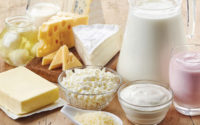Trends Dominating the Global Yogurt Market
Rising incidences of lifestyle disorders and growing awareness about healthy diet have led to an increased adoption of functional foods, especially probiotic-fortified foods. Amongst probiotic functional foods and beverage category, yogurt holds a significant market share due to its greater consumption and rising popularity among health-conscious population. Besides being an essential part of various cuisines around the world, yogurt serves as a healthy option to consumers for daily consumption due to its greater accessibility and affordability. Several research studies suggests that consuming Yogurt offer consumers a host of benefits such as reducing the risk of type-2 diabetes, boost immunity, enhances bone health, help with cognitive function and mood, safeguard against colorectal cancer, and reduce high blood pressure & bad cholesterol.
In 2021, yogurt sales in the United States amounted to USD7.24 billion, up from USD5.6 billion in 2011. Presence of large number of yogurt brands as well as huge spending for yogurt marketing have led to its ubiquitous availability across various distribution channels and rapid adoption by consumers. Rising demand for healthier low-sugar varieties with fewer additives are providing significant opportunities for the producers to amplify their yogurt sales and raise margins. Fermentation remains central to Yogurt’s appeal among young audiences due to its sour taste and range of flavours. However, the target market for yogurt is rapidly expanding with increase in awareness among people for weight loss, rising personal disposable income of the population, growing incidences of chronic diseases, and improved standard of living are some of the factors contributing to the significant growth of the global yogurt market. Rising popularity of fruit-flavoured Yogurt such as mango, strawberry, chocolate, banana, and others and their increasing consumption in desserts are contributing to the market growth.
According to TechSci Research report on, “Global Yogurt Market By Fat Content (Regular, Low Fat, Fat Free), By Type (Flavored, Non Flavored), By Form (Conventional Yogurt, Greek Yogurt, Set Yogurt, Frozen Yogurt, Yogurt Drinks, Others), By Packaging (Plastic Bottles, Tetra Packs, Others), By Distribution Channel (Direct Selling/Wholesale and Retail Sales), By Region, Competition, Forecast & Opportunities, 2025=7”, the global yogurt market is expected to grow at impressive rate through 2027. The market growth can be attributed to the rising awareness towards healthy food and increasing young population. Besides, high availability of yogurt with nutritional value and protein content are expected to boost the growth of the global yogurt market in the coming years.
Some trends expected to dominate the global yogurt market in 2022 are as follows.
- Rising Demand for Innovative Packaging
With continued demand for delicious and high-quality foods, producers of yogurt are experimenting new ways of enterprise marketing for fast moving consumer goods attract consumers. Packaging design is one of the attributes that give rise to positive purchasing attitude and match consumers’ preferences. Innovation in food packaging has also led to the incorporation of active components whose function is to extend the product quality and longevity of the product. Many brands are ditching plastic packaging and adopting bottled glass or ceramics to reduce environmental impact and classify their product as premium. Smart packaging has enabled smartphone users to scan a product’s unique digital code, which can help them access all the details. To appeal Gen Z population, yogurt brands are introducing products in sustainable packaging that represents nutritional information and ingredients so that they can make an informed choice. In 2021, one of the leading yogurt brands, Chobani announced that it is transitioning from plastic to paper-based cups for their single-serve oat blend yogurt. Chobani’s paper cup is 80% paperboard, which can handle the temperature changes, moisture and keep the products fresh. Some other brands are also working to develop smart and sustainable packaging, which reduces harm to the environment while also maintain the quality of the product.
- More Ready-to-Drink Options
Consumers are preferring ready-to-drink protein options such as drinkable yogurt, yogurt smoothies, lassi, etc. due to their functional probiotics and enhanced convenience of drinking it on-the-go. Many brands are introducing drinkable yogurt rather than spoonable to attract young and busy customers. Chobani launched Low-Fat Greek Yogurt Shake, Califia introduced Dairy-Free Yogurt Cultured Nutmilk Drink, Morinaga launched Aloe Yogurt Drink for skin in recent years, witnessing consumer shift towards drinkable yogurts. New savory drinkable yogurt flavours such as carrots, beetroots, tomatoes are becoming huge hit among consumers. Although drinkable yogurts started out in Japan with the introduction of Yakult probiotics, now the market has expanding to China and India, which are fastest-growing markets. Rising personal disposable income of the population, rising incidences of chronic disorders, and increased awareness regarding health and well-being are contributing to the rapid adoption of drinkable yogurt market.
- Increasing Online Sales of Yogurt
Rapid expansion of e-commerce grocery stores is presenting huge opportunities for the yogurt brands to tap potential customers. Many consumers are opting for online ordering for extra safety and convenience of home delivery. Being a convenient and ready-to-eat snackable product, yogurt checks all the boxes for busy consumers who want to keep themselves and their families healthy. Many yogurt manufacturers are incorporating shelf-stable yogurt which requires no cooling and can be stored in pickup lockers.
- Expanding lactose-free yogurt options
Dairy-free options in the beverage category are gaining a lot of traction due to expanding population of vegans and lactose-intolerants. Major US yogurt brands like Yoplait and Activia are incorporating lactase to create 100% lactose-free dairy yogurt to meet the growing demands. Vegan yogurts such as flax milk yogurt and hemp yogurt offer same digestive benefits as dairy-based yogurts. As the market for vegan yogurt is increasing, market players are introducing many other varieties fortified with vitamins and minerals to make them healthier and tastier just like conventional yogurt. Several animal welfare associations and non-government organizations are spreading awareness regarding their health benefits, which is also expected towards growing adoption of lactose-free yogurt and rising prevalence of clean label products. Amongst plant-based yogurt, the soy segment accounts for the highest share since soy is an excellent protein and helps to reduce cholesterol and blood sugar levels. Besides, coconut and rice yogurt are also gaining immense popularity as they are considered to be least allergenic milk amongst all dairy milk alternatives. Moreover, market players are introducing new sugar-free drinkable yogurt products without really compromising the taste while providing more nutritional benefits.
- Technological innovations for yogurt production
New dairy technologies are enabling manufacturers to increase a higher level of protein that is currently possible for yogurt in both spoonable and drinking yogurt products. The new dairy technology, Glanbia Nutritionals’ UltraHi Protein Yogurt Technology help the manufacturers to achieve 20-50 grams of protein per serving. Some other novel processing technologies such as high-pressure processing, high-pressure homogenization, enzymatic crosslinking by transglutaminase, ultrasonic processing etc. are improving the quality of existing products and producing new food structures and textures, which is ultimately adding to the market growth.
With growing health-consciousness among customers and clean product demand, the yogurt market will expand significantly in the coming years. However, the trends will keep on changing as per consumer preferences for eating and drinking dairy foods and beverages. According to research report, “United States Yogurt Market By Type (Non-Flavored, Flavored), By Fat Content, (Regular, Low Fat, Fat-Free), By Form (Conventional Yogurt, Set Yogurt, Greek Yogurt, Frozen Yogurt, Yogurt Drinks and Others), By Packaging (Pouches, Plastic Bottles, Tetra Packs and Others), By Distribution Channel (Convenience Stores, Independent Small Grocers, Supermarket/Hypermarket, Online Channel), By Region, Competition, Forecast & Opportunities, 2026”, the United States yogurt market is anticipated to reach a market size of USD7.6 billion by 2026. The market can be attributed to the Americans’ inclination towards health consciousness and rising preference for flavoured yogurt.
Contact
Mr. Ken Mathews
708 Third Avenue,
Manhattan, NY,
New York – 10017
Tel: +1-646-360-1656
Email: [email protected]
Website: https://www.techsciresearch.com



